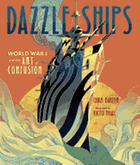
"One of the ships on this page is painted in sneaky, stripy camouflage. You probably can't even see it. Oh. You can see it? Hmmmmmmm."
The striped ship, depicted in bright blues and yellows, is a World War I Allied vessel. In 1917, the Central Powers began attacking Allied non-fighting ships to cut off Britain and win the war by starving the island nation. Desperate to feed its people, Britain tried "different things to stop the submarine attacks"; Royal Naval Volunteer Reserve lieutenant-commander Norman Wilkinson was the most well-known of those who floated the idea to camouflage ships. He said, "since it was impossible to paint a ship so that she could not be seen by a submarine, the extreme opposite was the answer--to paint her... in such a way as to break up her form and thus confuse a submarine officer as to the course on which she was heading."
And so the "dazzle ship" was born: more than 3,000 U.S. and British ships were painted with the crazy-looking patterns. As developed for children by author Chris Barton (Whoosh!), this story shows that "sometimes desperate times call for dazzling measures"; ingenuity is important, especially in the most trying of times. Paired with Barton's welcoming language and accessible story, Victo Ngai's illustrations sparkle. Using mixed analogue and digital media, she re-creates historical map templates and incorporates her own dazzle, creating overlapping and interconnecting patterns with strong lines and bright colors; each double-page spread is an abundance of color and texture and shape. Dazzle Ships shines and shows that "a willingness to tackle problems by trying the unlikely, the improbable, the seemingly bonkers will always be needed." --Siân Gaetano, children's and YA editor, Shelf Awareness

